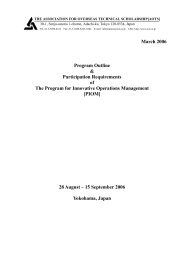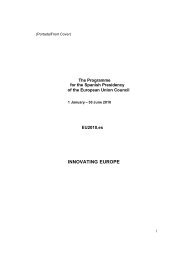Analysis of the Operation and Financial Condition of the Enterprise
Analysis of the Operation and Financial Condition of the Enterprise
Analysis of the Operation and Financial Condition of the Enterprise
Create successful ePaper yourself
Turn your PDF publications into a flip-book with our unique Google optimized e-Paper software.
<strong>Analysis</strong> <strong>of</strong> <strong>the</strong> <strong>Operation</strong> <strong>and</strong> <strong>Financial</strong> <strong>Condition</strong> <strong>of</strong> <strong>the</strong> <strong>Enterprise</strong>The operating cycle can be shortened on account <strong>of</strong> <strong>the</strong> technological process <strong>and</strong> <strong>the</strong>debtors’ payment period, while <strong>the</strong> cash cycle can be shortened on account <strong>of</strong> both <strong>the</strong>abovementioned factors <strong>and</strong> by reducing <strong>the</strong> rate <strong>of</strong> <strong>the</strong> turnover <strong>of</strong> trade creditors.4.5. Pr<strong>of</strong>itability measuresPr<strong>of</strong>itability is <strong>the</strong> return from business activities in percent reflecting how wellan enterprise is doing in terms <strong>of</strong> gaining pr<strong>of</strong>it, <strong>and</strong> it allows to objectively evaluate <strong>the</strong>business operations <strong>of</strong> an enterprise. In some sources <strong>of</strong> reference <strong>the</strong> term <strong>of</strong> pr<strong>of</strong>itabilityis defined in different ways:Pr<strong>of</strong>itability may be defined in various ways, for example: return from business operations in percent; <strong>the</strong> capacity to generate enough pr<strong>of</strong>it to retain <strong>the</strong> capital invested <strong>and</strong> to raisenew capital; measure <strong>of</strong> efficiency <strong>of</strong> enterprise operations describing <strong>the</strong> relationshipbetween <strong>the</strong> amount <strong>of</strong> pr<strong>of</strong>it <strong>and</strong> ano<strong>the</strong>r value, which is interrelated with <strong>the</strong>respective amount <strong>of</strong> pr<strong>of</strong>it; interest proceeds from <strong>the</strong> capital invested in an enterprise; relationship between pr<strong>of</strong>it mass <strong>and</strong> investment.The main reference source for pr<strong>of</strong>it evaluation <strong>and</strong> analysis is <strong>the</strong> incomestatement. There is a range <strong>of</strong> ratios used in <strong>the</strong> analysis by considering <strong>the</strong>ir dynamicsover several accounting periods. An enterprise is considered to be unpr<strong>of</strong>itable if it doesnot make any pr<strong>of</strong>it. If pr<strong>of</strong>it is < 0, pr<strong>of</strong>itability is also < 0.Pr<strong>of</strong>itability measures illustrate <strong>the</strong> relationship between net turnover <strong>and</strong> netincome in comparison with <strong>the</strong> assets <strong>of</strong> an enterprise. These are usually expressed inpercent. The higher <strong>the</strong> level <strong>of</strong> this interest is, <strong>the</strong> higher <strong>the</strong> efficiency <strong>of</strong> an enterprise. If<strong>the</strong> level <strong>of</strong> <strong>the</strong>se measures is low, an enterprise faces difficulties <strong>of</strong> development; if <strong>the</strong>seproblems are not corrected in due time, an enterprise can expect an operating crisis.The primary measure <strong>of</strong> pr<strong>of</strong>itability is pr<strong>of</strong>it. In a very simple sense pr<strong>of</strong>itabilityis determined by dividing <strong>the</strong> pr<strong>of</strong>it <strong>of</strong> an enterprise by its total or equity capital.In <strong>the</strong> course <strong>of</strong> pr<strong>of</strong>itability analysis usually <strong>the</strong> amount <strong>of</strong> capital or propertyemployed or net turnover is assumed as <strong>the</strong> values affecting <strong>the</strong> amount <strong>of</strong> pr<strong>of</strong>it.The level <strong>of</strong> pr<strong>of</strong>itability depends on <strong>the</strong> specifics <strong>of</strong> <strong>the</strong> enterprise operations, <strong>the</strong>structure <strong>of</strong> turnover <strong>and</strong> o<strong>the</strong>r factors. There are no absolutes criteria used in evaluation <strong>of</strong><strong>the</strong> level <strong>of</strong> pr<strong>of</strong>itability. Its increase, however, (over <strong>the</strong> previous periods) is being valuedpositively. Continuously low levels <strong>of</strong> pr<strong>of</strong>itability or negative pr<strong>of</strong>itability are a pro<strong>of</strong> <strong>of</strong> afailure in business. If this failure is not corrected an enterprise may face bankruptcy.<strong>Enterprise</strong> management is interested in increased levels <strong>of</strong> pr<strong>of</strong>itability, as one <strong>of</strong>its targets is to gain maximum pr<strong>of</strong>it <strong>and</strong> to provide benefits to <strong>the</strong> owners <strong>and</strong> <strong>the</strong>shareholders.Pr<strong>of</strong>itability is described <strong>and</strong> assessed by three aspects: Trading pr<strong>of</strong>itability (return from sales) – demonstrates how much pr<strong>of</strong>it has beengained in an enterprise per one unit <strong>of</strong> net turnover.81
















